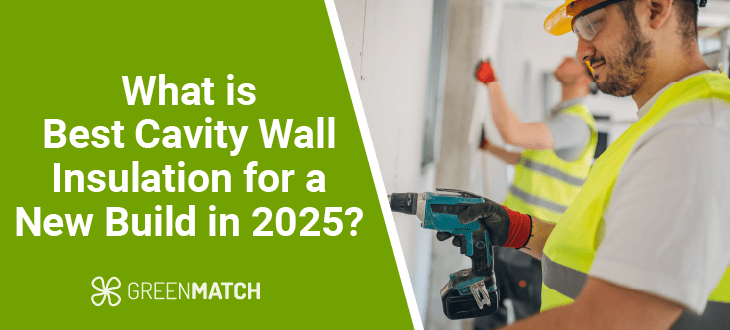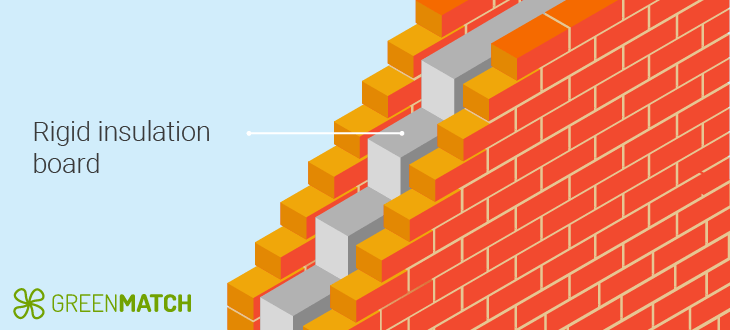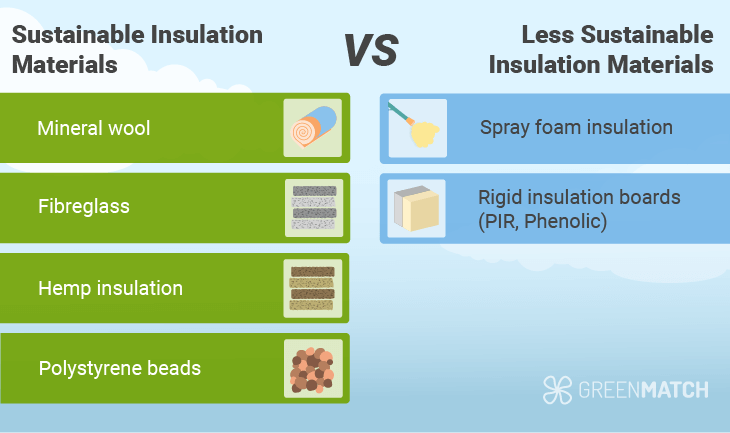Answer these simple questions and we will find you the BEST prices
Which type of solar quotes do you need?
It only takes 30 seconds
100% free with no obligation

Get Free quotes from insulation specialists near you

Save money by comparing quotes and choosing the most competitive offer

The service is 100% free and with no obligation
- GreenMatch
- Insulation
- Wall Insulation
- Cavity Wall Insulation
- Cavity Wall Insulation New Build
What is the Best Cavity Wall Insulation for a New Build in 2025?


- Cavity walls consist of two layers with a gap or cavity between them. If your home was constructed after the 1920s, it will likely have a cavity wall.
- Approximately one-third of the heat lost in an uninsulated residence dissipates through the walls. Properly insulating cavity walls can conserve energy and reduce heating expenses.
- Rigid insulation boards and Foam insulation are by far the best cavity wall insulation for a new build in the UK due to their thermal performance, moisture resistance, and gap-filling capabilities.
In 2025, selecting the most efficient cavity wall insulation for new builds is important for energy efficiency and comfort. Insulation technology advances deliver many choices, each with unique benefits for specific project needs. This guide investigates the top cavity wall insulation options available this year, stressing their advantages, disadvantages, and regulations to help make informed decisions for any new-build project.
Thinking about insulating your home? Let GreenMatch make it easy for you. There is no need for endless online searches and scheduling appointments. Just fill out a quick online form in 30 seconds, and you'll receive up to 3 free quotes from trusted installers in your area. Take the first step now by clicking the button below!
Fill in the form in just 1 minute
What is the best cavity wall insulation for a new build?
Rigid insulation boards are the top choice for cavity wall insulation in new builds in the UK, thanks to their exceptional thermal performance and moisture resistance. Foam insulation follows closely behind, offering superior gap-filling capabilities and high thermal efficiency.
Rigid insulation boards

When constructing a new home, it's recommended to consider using rigid insulation boards like PIR (polyisocyanurate) and phenolic boards. These boards offer superior thermal performance, durability, and moisture resistance.
They have high R-values, which means they provide excellent thermal insulation with thinner layers compared to other materials, helping to achieve the required U-values for new builds. Their high moisture resistance also helps prevent cavity wall insulation causing damp cavity, which is critical for maintaining the building's integrity in the UK's climate. Additionally, these boards are durable, ensuring long-lasting insulation performance, making them an ideal choice for modern construction.
Rigid insulation boards are known for their superior insulating properties but often have a higher price tag than other insulation options. Additionally, their installation usually requires a broader cavity, which might challenge specific design requirements.
Foam insulation

Foam insulation is highly recommended for newly built homes due to its exceptional thermal performance and ability to fill gaps effectively. It provides excellent thermal resistance, helping to achieve high R-values and superior energy efficiency by minimising heat loss through walls. Its expanding nature allows it to fill gaps and voids, creating a continuous thermal barrier that reduces air leakage and improves insulation effectiveness. Despite these benefits, foam insulation can be more expensive than traditional materials like mineral wool or fibreglass.
However, it's important to note that foam insulation can result in excessive airtightness, which poses potential risks. A highly airtight home necessitates not just any ventilation system, but a well-functioning one, to maintain indoor air quality. Inadequate ventilation can result in overheating and carbon monoxide buildup.
How to select the best cavity wall insulation for your new build home
Regarding selecting the best cavity wall insulation for your newly built home, evaluating factors like thermal performance, cost-effectiveness, moisture resistance, and compliance with building regulations is important. Additionally, it is necessary to consider characteristics such as the local climate, cavity size, and installation requirements.
Thermal performance (U-value)
Rigid insulation boards like PIR and phenolic boards deliver excellent thermal performance and are particularly suitable for projects with limited space. Spray foam cavity wall insulation expands to fill gaps, creating a continuous thermal barrier that significantly reduces heat loss. Additionally, mineral wool offers good thermal insulation, fire resistance, and acoustic properties. Polystyrene beads are effective for cavity wall insulation and are easy to install. Carefully evaluating these materials can help you select the one that best meets your new build's thermal performance needs.
| Material | U-value (W/m²K) |
|---|---|
| Rigid Insulation Boards (PIR, Phenolic) | As low as 0.021 |
| Spray Foam Insulation | 0.024 - 0.027 |
| Mineral Wool | 0.032 - 0.040 |
| Polystyrene Beads | 0.031 - 0.038 |
Cost of insulation material
When planning for the cost of insulation materials for a new build, it's important to understand that prices can vary depending on the type of insulation. While some materials, like spray foam, tend to be more expensive, others, such as mineral wool and polystyrene beads, are more budget-friendly.
Below is a table showing different insulation materials suitable for newly constructed homes:
| Material | Average cost range (per m²) |
|---|---|
| Spray Foam Insulation | £25 - £50 |
| Rigid Insulation Boards (PIR, Phenolic) | £20 - £40 |
| Mineral Wool | £15 - £25 |
| Polystyrene Beads | £10 - £20 |
| Fiberglass | £5 - £10 |
| Hemp Insulation | £30 - £45 |
Cavity size
The size of the cavity wall gap must be assessed when selecting insulation materials. Some materials are better suited for smaller cavities, while others perform better in bigger gaps.
| Cavity size | Suitable materials |
|---|---|
| Small (less than 50mm) | Rigid Insulation Boards (PIR, Phenolic), Spray Foam |
| Medium (50mm - 100mm) | Mineral Wool, Polystyrene Beads |
| Large (more than 100mm) | Mineral Wool, Fiberglass, Hemp Insulation |
Selecting the suitable material for cavity size guarantees optimal insulation performance and energy efficiency for newly built homes.
Sustainability of the insulation material

Insulation materials can be more or less sustainable. Some materials are sustainable and recyclable, while others, like spray foam, are not.
Here are some sustainable insulation material options on the market:
- Mineral wool: composed from natural stone or recycled materials, it is fully recyclable and has a long lifespan, minimising the requirement for frequent replacement.
- Fibreglass: this material usually includes recycled glass, which is easily recyclable and has a minimal environmental footprint.
- Hemp insulation: highly sustainable, made from natural hemp fibres and biodegradable. Hemp is a renewable resource with a low carbon footprint.
- Polystyrene beads: this material can be recycled, but specific recycling processes are required. They also have a moderate environmental impact compared to natural materials.
Alternatively, there are some high performing, but less sustainable insulation materials on the market:
- Spray foam insulation: This material, derived from petrochemical products, is a clear example of a less sustainable option. Not only is it non-recyclable, but its production and disposal processes can also have a significant environmental impact.
- Rigid insulation boards (PIR, phenolic): although they are efficient for insulation, they are manufactured using non-renewable resources and are challenging to recycle.
Building regulations for cavity wall insulation in new build homes
New construction must include cavity wall insulation to meet current building regulations. The primary factor to consider is the age of your home. Homes constructed between the 1920s and 1980s generally have cavity walls. Since the 1980s, new building regulations have made it compulsory for newly built houses to incorporate insulation material within cavity walls.
The outer walls of any cavity wall must have a thickness greater than 260mm.
An excellent way to determine the appropriate level of insulation for cavity walls is to refer to your country's building specifications. These specifications are outlined in guidance documents detailing how to meet the energy efficiency standards in the Building Regulations:
- Approved Document L 2021 in England (ADL 2021)
- Approved Document L 2022 in Wales (ADL 2022)
- Technical Handbook 6 2022 in Scotland (TH6 2022)
| Country | Domestic u-values (W/m2K) | Non-domestic u-values (W/m2K) |
|---|---|---|
| England | 0,26 | 0,26 |
| Wales | 0,18 | 0,26 |
| Scotland | 0,17 | 0,21 |
Evaluating the thermal performance of a new building is important, with the u-value being a key factor. A lower u-value indicates better insulation and less heat loss. If high-quality insulation is a priority, several materials are worth considering.
Get multiple cavity wall insulation quotes for your new build home
Getting multiple quotes is your best bet at landing a bargain on your cavity wall insulation job. By properly researching and vetting your installer options, you increase your chances of finding a professional that is within your budget.
However, finding a professional that is also affordable can be a daunting task. Most prospective customers find themselves stuck in an endless loop of websites and phone calls, but luckily GreenMAtch UK can help free you from this burden.
Forget about countless online searches and scheduling appointments; complete our brief online form in 30 seconds. You'll get up to 3 free quotes from reliable installers near you. Multiple quotes can save you money, help you compare prices and different materials, and find the best installers for your project. Take the first step now by clicking the button below!
Fill in the form in just 1 minute
FAQ
The best cavity wall insulation for new builds often depends on specific elements like thermal performance, cost, and sustainability. Generally, spray foam insulation is recommended for its ability to create an airtight seal and fill even the most minor gaps, providing superior thermal performance and moisture resistance. Rigid insulation boards, like PIR and phenolic, are also popular due to their high thermal performance and thin profile, making them suitable for various cavity sizes.
Spray foam insulation is regarded as one of the most effective options because it creates an airtight seal and fills even the smallest gaps, providing superior thermal performance. However, rigid insulation boards like PIR and phenolic also work well, achieving the same insulation value as thicker materials with a thinner profile.
New construction must include cavity wall insulation to meet current building regulations. The primary factor to consider is the age of your home. Homes constructed between the 1920s and 1980s generally have cavity walls. Since the 1980s, new building regulations have made it compulsory for newly built houses to incorporate insulation material within cavity walls.
Building regulations for cavity wall insulation guarantee that energy efficiency and safety standards are met in new builds. Important requirements include achieving a specific U-value, usually 0.18 W/m²K, to minimise heat loss. Insulation materials must comply with UK regulations for thermal performance and fire safety.

Akif is a copywriter at GreenMatch since 2023. With a keen interest in community sustainability, green solutions and the role of digital media in identifying climate trends, he aims to hone in on his background in International Studies and Digital Media to provide a multidisciplinary approach to written content rooted in credible research and accuracy.
We strive to connect our customers with the right product and supplier. Would you like to be part of GreenMatch?

- What is the Best Cavity Wall Insulation for a New Build in 2025?
- What is the best cavity wall insulation for a new build?
- How to select the best cavity wall insulation for your new build home
- Building regulations for cavity wall insulation in new build homes
- Get multiple cavity wall insulation quotes for your new build home
- FAQ
